Contents
Winter garlic, like spring garlic, is grown in almost every garden, because it is difficult to overestimate its benefits to human health. It does not require specific care, prefers fertile sandy or loamy neutral soil. Outdoor winter garlic is cultivated in all regions, including areas with a harsh cold climate.
Types of garlic
According to the type of cultivation, the crop is divided into winter and spring species. Winter garlic usually brings a richer harvest, it begins to be consumed from the beginning of summer, even before full ripening. After ripening, it can be stored, but spring is easier to save until the next harvest.
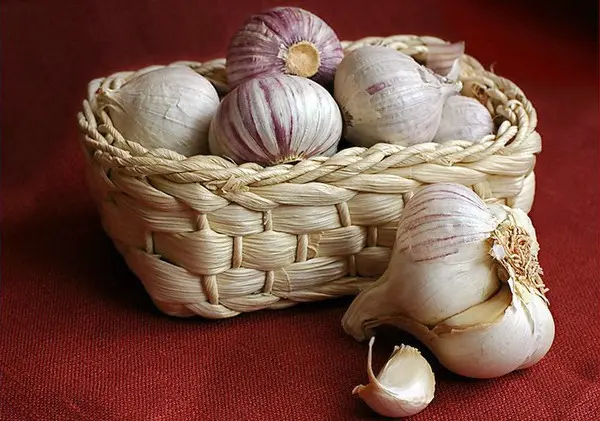
Winter garlic is represented by two main types: arrow and non-shoot. The non-shooting one is stored better if it is provided with proper care, removed in time, stored at a low positive temperature, then it can also lie down until spring. But when infected with viral diseases, it weakens, degenerates, and it is impossible to renew it – therefore, non-shooting garlic is less common.
The arrowing winter species gives the richest harvests; it is more often used as food in summer and autumn. A fully ripe, timely harvested crop can be stored for a long time. It does not degenerate, more precisely, it is simply updated with the help of bulbs.
The fact is that cloves grow in the ground, they can become infected with viruses or diseases of a different etymology. A new plant grown from an infected clove will initially be infected. In a few years it will no longer be possible to get a good plant – degeneration will come. In addition, over time, the garlic becomes smaller. Therefore, every 2-3 years, planting material must be updated.
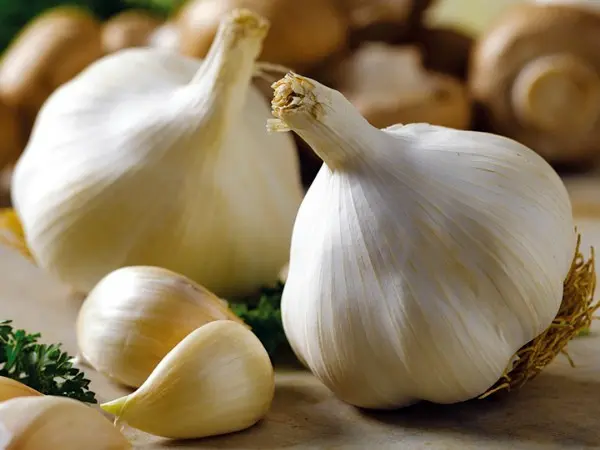
Garlic does not have seeds as such. Some believe that the bulbs are the seeds, but this, strictly speaking, is incorrect. Seeds have an ovule inside, after fertilization, it develops, a new plant grows from it. Nothing similar can be said about the bulb, bulbs are special organs that are used only for vegetative propagation. Shooting winter garlic simultaneously with flowering forms air bulbs, they are called bulbs.
For the sake of green feathers, perennial garlic is grown in the garden, which does not form bulbs, but forms seeds, with which it is propagated. It resembles an onion batun. Ornamental garlic also propagates through seeds, but it is not eaten at all, but grown for its appearance and phytoncides, with which it disinfects the air around it. Winter garlic, which we grow for cloves, has no seeds (in the botanical sense of the word).
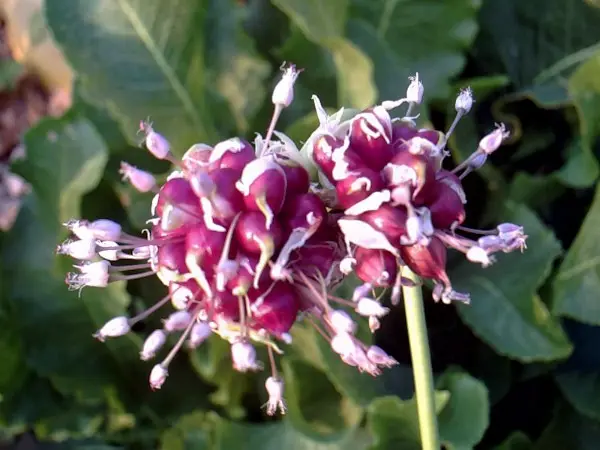
When to plant
Before winter, the crop should be planted in open ground a month (or a little more) before the onset of frost. This happens from the end of September to the end of November, depending on the region.
The main care during cultivation occurs in the spring, after the snow melts, as a new plant begins to grow after the soil has warmed up. But the teeth should take root before the onset of cold weather, but do not germinate above the surface of the earth, otherwise the frost will damage them.
The main difficulty lies in the fact that it is necessary to guess when the real frosts will come. Approximately, we all know when winter will come, and it’s worth focusing on this date, paying attention to the lunar calendar, the days recommended by him for planting.
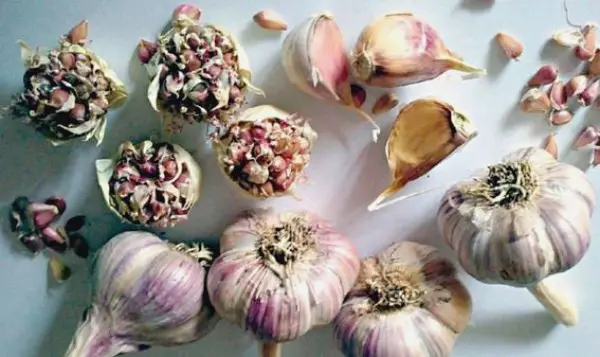
Preparation of seed and beds
Winter garlic is planted with cloves and single cloves grown from bulbs. The largest and strongest heads are grown from large cloves with a whole hard bottom. Planting material is disassembled into teeth just before planting, so that the bottom does not have time to dry, sorted by size. It is advisable to plant large and small teeth separately, small ones more often. Those whose bottoms crumble or scales exfoliate are discarded – most likely, they are affected by a nematode, which means that good plants will not work out of them, and even more so.
In order to improve the sowing material and not spend the entire crop on planting, they plant single-toothed teeth that have grown from bulbs before winter. From the air bulbs, not a full-fledged head is grown during the season, but one clove – a large one that has all the advantages of its variety. And from these single cloves, planted in open ground in autumn, excellent bulbs are obtained next summer, consisting of many cloves, as befits garlic. So the “seeds” give a full harvest in two years.
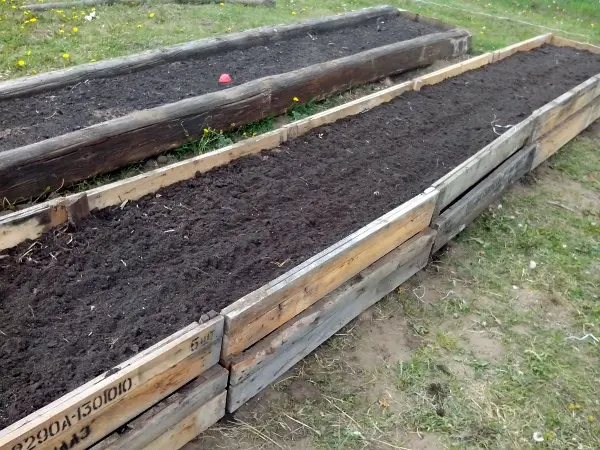
Before planting, teeth and single teeth will certainly be disinfected. To do this, they are placed for 25 minutes in a 1% solution of copper sulfate or for 2 hours in a solution of ash alkali. It is prepared as follows: 1 glass of wood ash is poured with 2 liters of water and boiled for at least half an hour.
Immediately after harvesting cucumbers, zucchini, squash, pumpkins or cabbage, the beds are prepared for garlic. They are dug up, potassium sulfate and superphosphate, compost or humus are added, watered if there is no rain, and left to rest for several weeks.
The earth should settle down so that later there will be no ground movement when the roots grow. They are not very deep, but grow vertically down. If, when the soil moves, they have to bend, rise up, then this will negatively affect the crop, and then no care can be corrected.
It is better to raise the bed by 10 centimeters so that melt water does not stagnate in the spring. Garlic generally grows well in raised beds.

Landing
In order for the garlic cloves to winter well, they are deepened by 10 or even 12 cm. The calculation is simple – there should be a distance to the top of the clove three times its length. The distance between large teeth is left at least 10 cm, between small ones you can leave less, since their bulbs will not grow very large. There should be 15 cm between rows. Some gardeners, when preparing grooves for planting, pour sand or ash on the bottom so that the teeth themselves do not touch the ground. They say that it will be easier for them to take root.
If the “seeds” nevertheless germinated before frost, they must be covered with a non-woven fabric or mulched with peat, you can mix sawdust with the ground. In the spring, all this must be removed. Garlic rarely freezes, but should not be allowed to get wet or burrow under the covering material when the ground thaws.
The main planting care will begin when the snow melts.
Video “Planting winter garlic”
This video offers a convenient method of boarding using 2 boards.
Care
Growing a crop in open ground does not require special care. It is watered, fed, weeded if necessary, the earth is loosened. As soon as the snow melts and it will be possible to come to the garden, the plantings are fed with a solution of chicken manure or mullein, superphosphate and potassium salt can be added. Proper care means regular watering. If there is no rain, then garlic is watered every week, top dressing can be combined with watering. If the soil is not very fertile, urea is added at the four-leaf phase, and when heads begin to form, they are fed with superphosphate. So that the crop can be stored, it is better to stop watering 20 days before the intended harvest.
When caring for arrow varieties, shooters are allowed to grow up to 20 cm, after which they are pinched, unless, of course, the owner is interested in growing bulbs. Usually, arrows are left on several plants and air “seeds” are allowed to ripen to improve the next year’s crop.
In order for the garlic heads to ripen more quickly, the earth is raked from them and left open by a third.
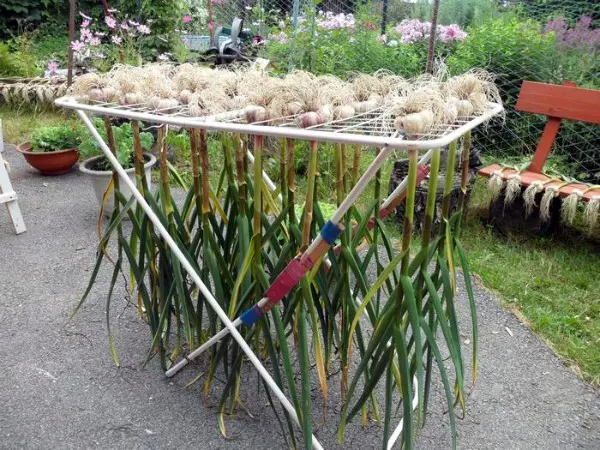
Cleaning
Harvest garlic approximately begin in mid-July. The exact timing depends on the variety that is grown, on caring for it, on the size of the bulb, and on the climate. When the leaves turn yellow and fall down, it’s time to harvest. Lateness will not affect the quality of the heads, but if the ripened bulbs remain in the ground, the scales will dissolve, the teeth will be exposed, and they will not be able to be stored in such an open form for a long time. All grown garlic cannot ripen at the same time; harvesting can still take several days.
The dug heads are left to dry right in the garden if the weather is dry. You can move them under the roof, but you need fresh air, better with a breeze. This moment of drying completes the ripening and care of the garlic. A week later, the crop is removed into the room and dried to the point that the root lobe can be easily rubbed with your fingers.
It is best to store garlic heads at a temperature not higher than +3 degrees, average humidity, then it will be possible to use them not only in summer, but even in winter.
Video “Winter garlic”
Thanks to this video, you will learn more about the types and varieties of garlic, the properties of winter varieties, the features of planting and growing, and much more.









